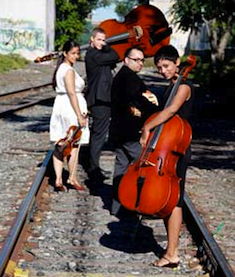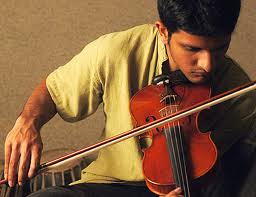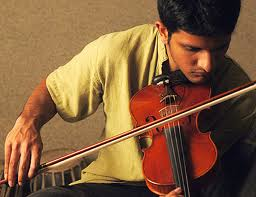
Photo by Dipyaman Ganguly
Classical Revolution, in the midst of its inaugural month-long festival, looked to the East and beyond, booking the folksy East Bay venue Ashkenaz on Sunday and showcasing the New York–based quartet Karavika, along with local treasure Gautam Tejas Ganeshan, in an evening of contemporary music sourced in India. It was a trip worth taking.
Ganeshan, by his own admission, is a unique act, trained as a violinist and educated in ethnomusicology at UCLA before he became a singer and a vital Bay Area impresario, presenting concerts of Indian music through his Sangati Center. Seated on a stool in front of the Ashkenaz stage, without a microphone, he vocalized his own poetry, mostly in English, in a style evocative of the Carnatic (South Indian) tradition. Accompanied by a traditionally garbed onstage ensemble, consisting of Mohan Rangan Govindaraj on bamboo flute, Vignesh Venkataraman on the two-headed mridangam drum, and Christina Boyd on the droning tambura, Ganeshan shared five of his alluring sets of lyrics. The slow movement through the text, with many repeated phrases, was evocative both of the ecstatic Qawwali song form shared by India and Pakistan, and of Baroque oratorio.
The latter connection applied also to Ganeshan’s vocal ornamentations, involving trills and glissandos, but not to the projection and vibrato associated with later Western classical music. Ganeshan’s instrument was neither strong nor showy, but rather eminently lyrical and supple, its dramatic impact bolstered by the singer’s expressive use of his arms and hands as he asked, in song, “Where shall I, your singer, go?” and affirmed that, “Despite nostalgia for paradise, the memory will suffice.” Communicating Ganeshan’s passionate texts, the combination of sound and message conveyed a new sort of Sunday worship and celebration.
To many listeners, the intervals of the Indian melas, or parent scales, which differ from the Western diatonic scale both in structure and in their use of microtones, are more familiar from their manifestation on the best-known Indian stringed instruments, the sitar and the sarod, neither of which was in evidence at Ashkenaz.
But Ganeshan’s technique paralleled that of the strings, and he also engaged in some sawal-jawab (give-and-take) with his virtuosic flautist and drummer. There were also echoes, though much miniaturized, of the sections of the familiar raga form (commonly performed on sitar and/or sarod), with an unmetered introductory alap section followed by the quicker, percussion-propelled gat section, and an exciting jhala, or conclusion. Communicating Ganeshan’s passionate texts, the combination of sound and message conveyed a new sort of Sunday worship and celebration.

After intermission, the ensemble Karavika sustained the taste of India, but within a contained chamber context, particularly by its melodic instrumentation of violin (Trina Basu), cello (Amali Premawardhana, sister of Classical Revolution founder Charith Premawardhana), and bass (Perry Wortman), with Sameer Gupta providing a rhythmic foundation on tabla drums, and the essential drone of the tambura supplied by — can you believe it? — an amplified smartphone app.
As with Ganeshan’s group, several of Karavika’s half-dozen pieces (all found on its self-produced CD, titled Sunrise) incorporated raga construction, with violin and cello introducing the melodic theme in unison or harmonized, and bass and tabla entering later. Basu and Premawardhana, both commanding performers, were particularly apt at bolstering and then relaxing the intensity of the music, extending their palette with pizzicatos and a variety of bowing techniques that, together, evoked both sitar and sarod.
Karavika’s first two offerings were based on Indian film music, nicely voiced and at times suggestive of some of the adventures of such crossover explorers as Edgar Meyer and Yo-Yo Ma. Ravi Shankar’s theme from the soundtrack of Pather Panchali, the 1955 film by Satayajit Ray, was charmingly reborn as a chamber piece in 9/8 time.
The Karavika original composition “Sunrise,” which closed out the evening, arguably provided the group its best showcase. Bay Area tenor saxophonist Prasant Radhakrishnan was brought in on a couple of numbers, but for the most part neither he nor the string players were able to get as far in their brief improvisatory sections as Radhakrishnan has gotten elsewhere, with the Asian American Orchestra. Whatever the proceedings, Wortman continued to provide handsome underpinnings, while Gupta worked a variety of intonation, aside from his intricate and reliable time-keeping.
The Karavika original composition “Sunrise,” which closed out the evening, arguably provided the group its best showcase. From a mélange of shimmering strings and haunting horn sounds, Radhakrishnan moved on to the jazziest of the set’s solos, and both Premawardhana and Basu proved that they can swing, when given the chance. Similar showings followed by Wortman and by Gupta, and the entire ensemble earned its standing ovation.
If this sounds like something you shouldn’t have missed, look toward the remainder of the First Annual Cultural Revolution Festival, with even more variety of genres and venues.

